Three
locomotives were ordered from Manning Wardle for the opening
of the Barnstaple to Lynton section.

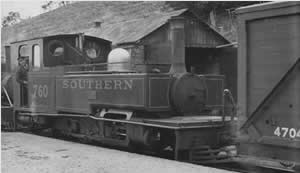
Manning Wardle
'Exe' at Lynton
At the last
minute, it seems that the directors then decided that a
further locomotive would be required. By then, a strike of
engineers in the UK, forced them to shop further a field.
Baldwin was chosen to supply. It is said that this
locomotive has caused more problems than all the others put
together.

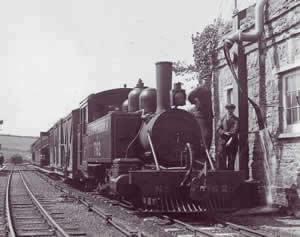
the Baldwin 'Lyn' at
Blackmoor
After the
operating experience of the Lynton and Barnstaple section,
the directors of the Minehead section ordered more powerful
locomotives from North British in 1900. These two
locomotives have shown themselves to be more suitable for
the Barbrook/Minehead section where their extra power has
come into its own. It has become standard practice for
passengers to change trains at Barbrook and only specials
are through running from Barnstaple to MInehead. Without any question, these two locomotives have
been the most successful on this railway and are much loved
by the crews. They are always turned out beautifully.

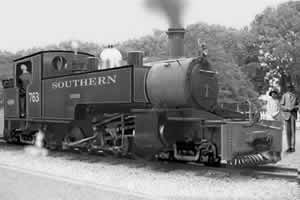
North British 4-6-4 'Axe'
at Barbrook in 1929. These were the most powerful
locomotives on the system until the
arrival of the Mallets
Once
Southern had absorbed the line, three new locomotives were
added to the roster. North British were unable to supply due
to other commitments so a further Manning Wardle and two heavy
Mallets built at Eastleigh were ordered. 'Lew' was in all
respects the same design as the originals except a more
commodious cab was provided with a flat back sheet.
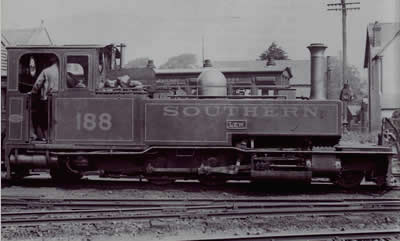
'Lew' at Pilton Yard
The first Mallet, 'River Avon'
was delivered in 1925 as an 0-6-0 0-6-0 and was not at first
a huge success.
Seeking to get a more powerful locomotive onto the line, in
order to do away with the expense of double-heading,
Eastleigh Works took the design elements of the ‘classic’
Manning-Wardle tank-engines and expanded on them to produce
an 0-6-0+0-6-0T Mallet articulated tank-engine, which
promised a big increase of power without sacrificing the
ability to negotiate sharp corners.
Early on, an
embankment collapsed under the unprecedented weight of the machine, it spread
the rails, rode roughly and proved extremely temperamental (track ties were
very quickly installed where rail spreading had occurred).
Engineers from Eastleigh arrived at
Barnstaple to learn how the new engine had fared in its first year of service.
Reports were not flattering. Somewhat abashed, 666’s designers made quick
amends to rectify what design flaws they could, and the second Mallet, 667
'River Brue', was found to be a much improved machine upon delivery in
November 1926. The key change being the addition of leading and trailing pony
trucks to steady her riding and spread axle loadings.
'River Avon',
after modifications during a 1929 return to Eastleigh to closely match 'Brue’s'
specifications has now been tamed into a superbly reliable machine.
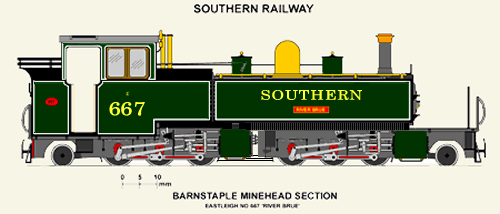

Mallet 'River Avon' at
Barnstaple
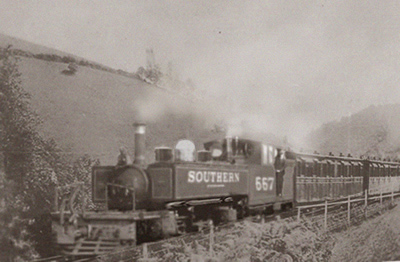
Mallet 'River Brue' near
Snapper
The move
towards diesel electric traction began in 1932 when the
first prototype railcar was delivered from Eastleigh. It was
powered by a Sulzer 200hp diesel electric unit and in many
ways was highly successful.

The original railcar at
County Gate.
The second
prototype was outshopped to Short Brothers of Rochester.
This company is more famous for building aircraft but they
also build some buses and trams. This arrived the following
year and many of the shortcomings of the original railcar
were resolved. It is built in a most modernistic manner and
much of the railcar is resplendent in polished metal.

The last service of
the railcar before being sold to Glenthorne

The second railcar, now sold
to the Glenthorne Estate.
Eastleigh
have now delivered what they describe as their 'Production
railcars'. These are most modern in their design and are
either three or four coach units. They are powered by the
mighty 400 hp Sulzer LD engine. A few trains are already in
service and are proving to be highly successful. The first
to be delivered, unit 302, is mounted on articulated bogies.
While these are excellent riding cars, the company has
experienced a lack of operating flexibility should a problem
occur. Railcars 301, 303, 304 and 305 are provided with
individual bogies and their design is far more modern than
unit 302. Unlike other equipment on the railway,
Westinghouse pressure brake systems are employed.

Railcar 302 on
test at Lancey Brook Viaduct in 1934 on a cold
misty morning.

A four coach
(301, 303 or 304)
railcar set crosses East Lyn Viaduct

railcars pass at County Gate
Upon
delivery of the new railcars, the two prototypes and 302 were sold to the Glenthorne Estate.
Following on
from the success of the new railcars, two diesel electric locomotives
have been on trial. From Armstrong Whitworth is the 2-6-0
0-6-2 articulated locomotive, 'River Avill'. It is said to be more
powerful than the large Mallets. From Eastleigh is a bo-bo
unit (River Aller), which while being less powerful,
is thought to ride better on the track. Both locomotives are
loaned on occasion to the Glenthorne Harbour Authority.
After
conclusion of the trials, a new joint venture scheme has been
initiated
between Southern and the Glenthorne Harbour Authority to
build a series of diesel locomotives based on a development
of 'River Aller' which was found to be much kinder to the
track than 'River Avill'. The first units of this scheme are
under trial both on the Southern main line and on the
Glenthorne branches. The Glenthorne design is a back to back unit of strikingly
modern appearance and is painted in Glenthorne livery. They are numbered 20 and 21 respectively.
Using the same chassis, the Southern prototype, 'River Kenn',
no.
764 is more sober in appearance and is also in service.

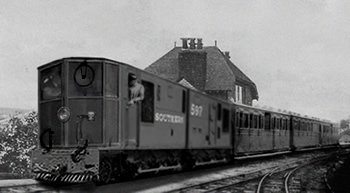
Armstrong Whitworth 'River
Avill'
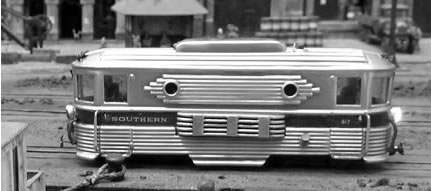
'River Aller' at Glenthorne Harbour